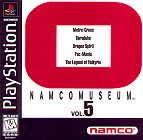Wii Play
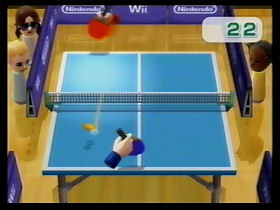 The Game: Wii Play gathers a collection of mini-games in one place, from fishing, billiards and target shooting to a futuristic hockey game and tank battles, each showcasing different ways that the Wii remote controls
The Game: Wii Play gathers a collection of mini-games in one place, from fishing, billiards and target shooting to a futuristic hockey game and tank battles, each showcasing different ways that the Wii remote controls  can be used. (Nintendo, 2007)
can be used. (Nintendo, 2007)
Memories: As with Wii Sports, Wii Play is an easy-to-pick-up but hard-to-put-down grouping of fairly simple minigames. Some of the games in Wii Play simulate real sports, while others delve into more abstract areas of game play. That’s the good news, and the even better news is that just about all of them are fun, making this another all-in-one first-party home run for Nintendo – if anyone knows a dozen different ways to use the Wii controllers, it should be the folks who made the things.
Red Dwarf: Beat The Geek

 The Game: Holly (and Holly) tax your brain with trivia questions about Red Dwarf (at either “viewer” or “geek” level) or about any number of other things (at “general knowledge”), with a time limit on each multiple-choice question. Some Red Dwarf-specific questions ask players to identify elements of scenes or even pieces of soundtrack music from the series. There are eight levels of six questions each; players who complete a round with no wrong answers will be given a code to enter at the main menu for a bonus game, and players who complete the entire quiz with no wrong answers will be given a two-point bonus question. Along the way, Holly (and Holly) offer helpful advice and critique your knowledge. (BBC Video / 2|entertain, 2006)
The Game: Holly (and Holly) tax your brain with trivia questions about Red Dwarf (at either “viewer” or “geek” level) or about any number of other things (at “general knowledge”), with a time limit on each multiple-choice question. Some Red Dwarf-specific questions ask players to identify elements of scenes or even pieces of soundtrack music from the series. There are eight levels of six questions each; players who complete a round with no wrong answers will be given a code to enter at the main menu for a bonus game, and players who complete the entire quiz with no wrong answers will be given a two-point bonus question. Along the way, Holly (and Holly) offer helpful advice and critique your knowledge. (BBC Video / 2|entertain, 2006)
Memories: This interactive DVD game contains the first new Red Dwarf footage shot since the BBC’s cult SF comedy series bowed out in the 1990s; that along is cause for some small celebration at the very least. Granted, it’s not a new episode or the delayed-until-it’s-vaporware feature film, but it’ll do. Norman Lovett and Hattie Hayridge reprise their roles as the two incarnations of Holly; that’s got to be worth the price of admission alone.
Turnabout
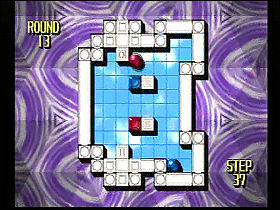
 The Game: A rotating box sits in the center of the screen, containing a maze, at least one mobile ball, and other moving elements such as sliding bars or boxes. Using the left and right D-pad buttons, players rotate the entire box, which will cause any of the mobile pieces to obey the laws of gravity and fall in that direction. The object of the game is to get all of the balls into contact with the jewel of the same color at the other end of the maze – which may not be as easy as it sounds! (Natsume, 2002)
The Game: A rotating box sits in the center of the screen, containing a maze, at least one mobile ball, and other moving elements such as sliding bars or boxes. Using the left and right D-pad buttons, players rotate the entire box, which will cause any of the mobile pieces to obey the laws of gravity and fall in that direction. The object of the game is to get all of the balls into contact with the jewel of the same color at the other end of the maze – which may not be as easy as it sounds! (Natsume, 2002)
Memories: As Sony eased its restrictions on Playstation licensing toward the end of the console’s life span (at this point, the PS2 was already on the market), heaps of cheap PS1 games hit store shelves. Some of these were pure shovelware, hastily cranked out to make a buck off that segment of the gaming populace that couldn’t afford to upgrade to the PS2. Quite a few were quickly-done localizations of games that had already been released – often as budget titles from the outset – in Japan. Turnabout is in the latter category, and unlike quite a few of the glut of games released in the PS1’s twilight, it’s a lot of fun.
Frogger
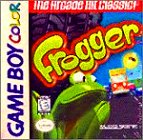
 The Game: You are a frog. Your task is simple: hop across a busy highway, dodging cars and trucks, until you get the to the edge of a river, where you must keep yourself from drowning by crossing safely to your grotto at the top of the screen by leaping across the backs of turtles and logs. But watch out for snakes and alligators! (Majesco, 1999)
The Game: You are a frog. Your task is simple: hop across a busy highway, dodging cars and trucks, until you get the to the edge of a river, where you must keep yourself from drowning by crossing safely to your grotto at the top of the screen by leaping across the backs of turtles and logs. But watch out for snakes and alligators! (Majesco, 1999)
Memories: Ah, the joys of Frogger. It’s still one of the simplest and most deceptively difficult arcade games  ever to come down the pike, and yet finding a decent port of it over the years has proven to be almost as difficult as getting the amphibious one across the road in the game’s sixth level. But ask anyone about favorite video games from the early 80s, and you’re almost certain to hear Frogger in that list. The popularity of the original Frogger is borne out by the fact that a series of licensees has attempted to turn out a modern-day descendant of Frogger, and while some of those have been fun in their own right, they’ve also barely lived up to the simple joy of the original.
ever to come down the pike, and yet finding a decent port of it over the years has proven to be almost as difficult as getting the amphibious one across the road in the game’s sixth level. But ask anyone about favorite video games from the early 80s, and you’re almost certain to hear Frogger in that list. The popularity of the original Frogger is borne out by the fact that a series of licensees has attempted to turn out a modern-day descendant of Frogger, and while some of those have been fun in their own right, they’ve also barely lived up to the simple joy of the original.
Command & Conquer: Red Alert
![]()
 The Game: It’s the Cold War all over again – but worse. Tampering with the timeline has wreaked immeasurable damage with the development of technology, and the result is a new wave of deadly weapons, including Tesla tanks and turrets (which discharge immense electrical energy at their opponents) and Chrono-tanks (which can shift their position on the map instantly for a brief time). You must build and protect your base, produce units necessary to defend and attack, and orchestrate an invasion of enemy territory – all while accumulating as few casualties as possible. (Electronic Arts [developed by Westwood Studios], 1996)
The Game: It’s the Cold War all over again – but worse. Tampering with the timeline has wreaked immeasurable damage with the development of technology, and the result is a new wave of deadly weapons, including Tesla tanks and turrets (which discharge immense electrical energy at their opponents) and Chrono-tanks (which can shift their position on the map instantly for a brief time). You must build and protect your base, produce units necessary to defend and attack, and orchestrate an invasion of enemy territory – all while accumulating as few casualties as possible. (Electronic Arts [developed by Westwood Studios], 1996)
Memories: Westwood’s real-time strategy classic is a major evolutionary leap from the original Command & Conquer, with vast improvements in the artificial intelligence used by both your soldiers and by computer controlled enemies. And it’s a tough game! It’s pretty common practice for me, despite a couple of years of playing Dune 2000 (a later Westwood game which is built on the same engine as Red Alert), to build up quite a nice base and then get my ass kicked big time.
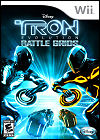 The Game: In the era before Clu’s forceful takeover of the grid, Tron is kept busy with securing the digital world, leaving a vacuum from which a new champion can emerge in the grid games. Various factions have their own champions, who now battle each other on the game grid in various contests: light cycles, hyperball, disc battles, tank battles, and various vehicle races. (Disney Interactive, 2010)
The Game: In the era before Clu’s forceful takeover of the grid, Tron is kept busy with securing the digital world, leaving a vacuum from which a new champion can emerge in the grid games. Various factions have their own champions, who now battle each other on the game grid in various contests: light cycles, hyperball, disc battles, tank battles, and various vehicle races. (Disney Interactive, 2010)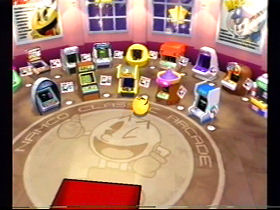 The Game: Join Pac-Man as he rolls around the carnival-like grounds of the Namco Museum. Six “remixed” games are featured:
The Game: Join Pac-Man as he rolls around the carnival-like grounds of the Namco Museum. Six “remixed” games are featured:  The Game: DSI strikes again with Gauntlet and Rampage, two nearly perfect arcade conversions for the Game Boy Advance. In Gauntlet you’ll trade shots with ghosts, demons, and Death himself. In Rampart you’ll defend your ground and exchange buckshot with more worldly enemies. (DSI Games/Atari, 2006)
The Game: DSI strikes again with Gauntlet and Rampage, two nearly perfect arcade conversions for the Game Boy Advance. In Gauntlet you’ll trade shots with ghosts, demons, and Death himself. In Rampart you’ll defend your ground and exchange buckshot with more worldly enemies. (DSI Games/Atari, 2006)

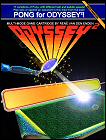 Travel back in time to the dawn of interactive electronic games. Pong For Odyssey2 offers a standard two-player version of the classic video table tennis game, as well as electronic recreations of the analog version of the game available on the first home game
Travel back in time to the dawn of interactive electronic games. Pong For Odyssey2 offers a standard two-player version of the classic video table tennis game, as well as electronic recreations of the analog version of the game available on the first home game  The Game: By passing up a lucrative programming job within ENCOM, Alan “Jet” Bradley Jr. has earned the disdain of his father, the creator of the Tron security program. But when Jet’s father disappears under mysterious circumstances, Jet goes to the lab and discovers that his father’s most trusted program, Ma3a, has instructions to digitize Jet into ENCOM’s mainframe – a process not unlike the one Kevin Flynn endured 20 years before. Once inside the computer world, Jet trains for a mission to free the system from the spreading corruption of Thorne, another digitized user whose botched entry into the computer world left him twisted and evil – and along the way, Jet hopes to discover how he can help free his father as well. (Buena Vista Interactive, 2003)
The Game: By passing up a lucrative programming job within ENCOM, Alan “Jet” Bradley Jr. has earned the disdain of his father, the creator of the Tron security program. But when Jet’s father disappears under mysterious circumstances, Jet goes to the lab and discovers that his father’s most trusted program, Ma3a, has instructions to digitize Jet into ENCOM’s mainframe – a process not unlike the one Kevin Flynn endured 20 years before. Once inside the computer world, Jet trains for a mission to free the system from the spreading corruption of Thorne, another digitized user whose botched entry into the computer world left him twisted and evil – and along the way, Jet hopes to discover how he can help free his father as well. (Buena Vista Interactive, 2003)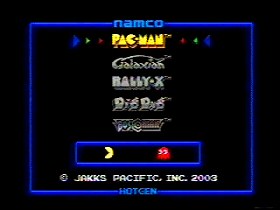
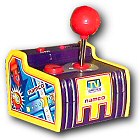 Memories: After I reviewed the dandy Techno Source Intellivision 25-in-1 TV Game, at least one e-mail suggested that I wasn’t being critical enough in my review. I praised that dandy self-contained gadget for capturing the flavor of those 25 classic Intellivision games, even if a lot of the finer details were left out. Those of you who thought I was going easy on that game should just stop reading this review now. Because I kinda dig this quintet of Namco goodness – with some significant reservations.
Memories: After I reviewed the dandy Techno Source Intellivision 25-in-1 TV Game, at least one e-mail suggested that I wasn’t being critical enough in my review. I praised that dandy self-contained gadget for capturing the flavor of those 25 classic Intellivision games, even if a lot of the finer details were left out. Those of you who thought I was going easy on that game should just stop reading this review now. Because I kinda dig this quintet of Namco goodness – with some significant reservations.  The Game: Remember those BASIC programming how-to books in the 70s and 80s with the do-it-yourself minigames you could type in and run? They’re back. Daniel Bienvenu’s tribute to those classic games has a twist though: it’s running
The Game: Remember those BASIC programming how-to books in the 70s and 80s with the do-it-yourself minigames you could type in and run? They’re back. Daniel Bienvenu’s tribute to those classic games has a twist though: it’s running 
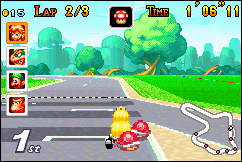 The Game: It’s a big day at the races, with a field of drivers selected from the Mushroom Kingdom: Mario, Luigi, Princess Peach, Toad, Bowser, and even Donkey Kong Jr. are among the racers vying for the top spot. From the grassy Mushroom course to the punishingly muddy Star course to the oceanside Flower course, there are challenges, hairpin turns and obstacles. Whoever can learn to navigate each course the fastest without ending up out of bounds struggling to get back on the course will be the winner. (Nintendo, 2001)
The Game: It’s a big day at the races, with a field of drivers selected from the Mushroom Kingdom: Mario, Luigi, Princess Peach, Toad, Bowser, and even Donkey Kong Jr. are among the racers vying for the top spot. From the grassy Mushroom course to the punishingly muddy Star course to the oceanside Flower course, there are challenges, hairpin turns and obstacles. Whoever can learn to navigate each course the fastest without ending up out of bounds struggling to get back on the course will be the winner. (Nintendo, 2001) The Game: You’re the pilot of a ground-based mobile weapons platform, and there are buttloads of alien meanies headed right for you. Your only defense is a trio of shields which are degraded by any weapons fire – yours or theirs – and a quick trigger finger. Occasionally a mothership zips across the top of the screen. When the screen is cleared of invaders, another wave – faster and more aggressive – appears. When you’re out of “lives,” or when the aliens manage to land on Earth… it’s all over. This edition adds two new modes, a timed game with a slightly updated retro look, and a 3-D mode which puts the player right behind the cannon, now expanded to a giant 3-D representation. (D3 Publisher [under license from Taito], 2001)
The Game: You’re the pilot of a ground-based mobile weapons platform, and there are buttloads of alien meanies headed right for you. Your only defense is a trio of shields which are degraded by any weapons fire – yours or theirs – and a quick trigger finger. Occasionally a mothership zips across the top of the screen. When the screen is cleared of invaders, another wave – faster and more aggressive – appears. When you’re out of “lives,” or when the aliens manage to land on Earth… it’s all over. This edition adds two new modes, a timed game with a slightly updated retro look, and a 3-D mode which puts the player right behind the cannon, now expanded to a giant 3-D representation. (D3 Publisher [under license from Taito], 2001) The Game: If there can be a collective of Super Friends, why not a cabal of supervillains? The forces of evil from the various anime series created by Tatsunoko Studios have merged their powers, so the heroes of those same universes must join forces to save us all. This saving takes the form of a lot of unarmed combat – you can probably figure out what to do from here. You must do battle with the great villains of those various shows – or even other heroes, in Vs. mode. Series whoses characters are included are Gatchaman (better known as Battle Of The Planets in the U.S.), Tekkaman, Casshan, and Polymer The Ha-Ri-Ken Fighter. A new character in the classic Tatsunoko Studios mold, Volter The Lightning, is introduced here for the first time. (Takara Toys, 2000)
The Game: If there can be a collective of Super Friends, why not a cabal of supervillains? The forces of evil from the various anime series created by Tatsunoko Studios have merged their powers, so the heroes of those same universes must join forces to save us all. This saving takes the form of a lot of unarmed combat – you can probably figure out what to do from here. You must do battle with the great villains of those various shows – or even other heroes, in Vs. mode. Series whoses characters are included are Gatchaman (better known as Battle Of The Planets in the U.S.), Tekkaman, Casshan, and Polymer The Ha-Ri-Ken Fighter. A new character in the classic Tatsunoko Studios mold, Volter The Lightning, is introduced here for the first time. (Takara Toys, 2000)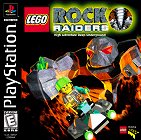


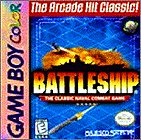 The Game: Two fleets of four warships conduct long-distance naval warfare, randomly firing torpedoes (and occasionally some higher-powered ordnance) at each other, guessing at the positions of their targets. Whoever sinks the entire opposing fleet first is the victor. (Hasbro Interactive, 1999)
The Game: Two fleets of four warships conduct long-distance naval warfare, randomly firing torpedoes (and occasionally some higher-powered ordnance) at each other, guessing at the positions of their targets. Whoever sinks the entire opposing fleet first is the victor. (Hasbro Interactive, 1999) The Game: Old Atari cartridges taking up too much space in your apartment? Have no fear – a huge portion of Activision’s catalog of titles for the 2600 have been squeezed onto a single CD. (Activision, 1999)
The Game: Old Atari cartridges taking up too much space in your apartment? Have no fear – a huge portion of Activision’s catalog of titles for the 2600 have been squeezed onto a single CD. (Activision, 1999)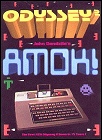 The Game: You’re alone in a maze filled with armed, hostile robots who only have one mission – to kill you. If you even so much as touch the walls, you’ll wind up dead. You’re a little bit faster than the robots, and you have human instinct on your side…but even that won’t help you when SmileyBot, a deceptively friendly and completely indestructible smiley face, appears to destroy you if you linger too long in any one part of the maze. The object of the game? Try to stay alive however long you can. (John Dondzila Classic Gaming Creations, 1998)
The Game: You’re alone in a maze filled with armed, hostile robots who only have one mission – to kill you. If you even so much as touch the walls, you’ll wind up dead. You’re a little bit faster than the robots, and you have human instinct on your side…but even that won’t help you when SmileyBot, a deceptively friendly and completely indestructible smiley face, appears to destroy you if you linger too long in any one part of the maze. The object of the game? Try to stay alive however long you can. (John Dondzila Classic Gaming Creations, 1998)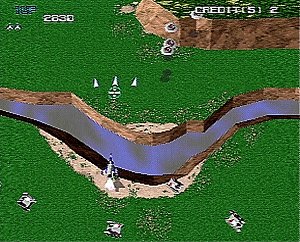
 Memories: This somewhat obscure Namco title updates and revives their classic arcade title Xevious, which accumulated a cult following in 1983 when the game was released Stateside by Atari. Truth be told, Xevious 3D/G+ doesn’t rewrite the book or reinvent the wheel. For the most part, the game simply puts the original Xevious in a vaguely third-person 3-D perspective, adds some weapons and enemies (most notably the enormous and hard-to-kill Bosses), and kicks ass graphically. I liked this a lot. It has a great deal of respect and reverence for its source material.
Memories: This somewhat obscure Namco title updates and revives their classic arcade title Xevious, which accumulated a cult following in 1983 when the game was released Stateside by Atari. Truth be told, Xevious 3D/G+ doesn’t rewrite the book or reinvent the wheel. For the most part, the game simply puts the original Xevious in a vaguely third-person 3-D perspective, adds some weapons and enemies (most notably the enormous and hard-to-kill Bosses), and kicks ass graphically. I liked this a lot. It has a great deal of respect and reverence for its source material. 